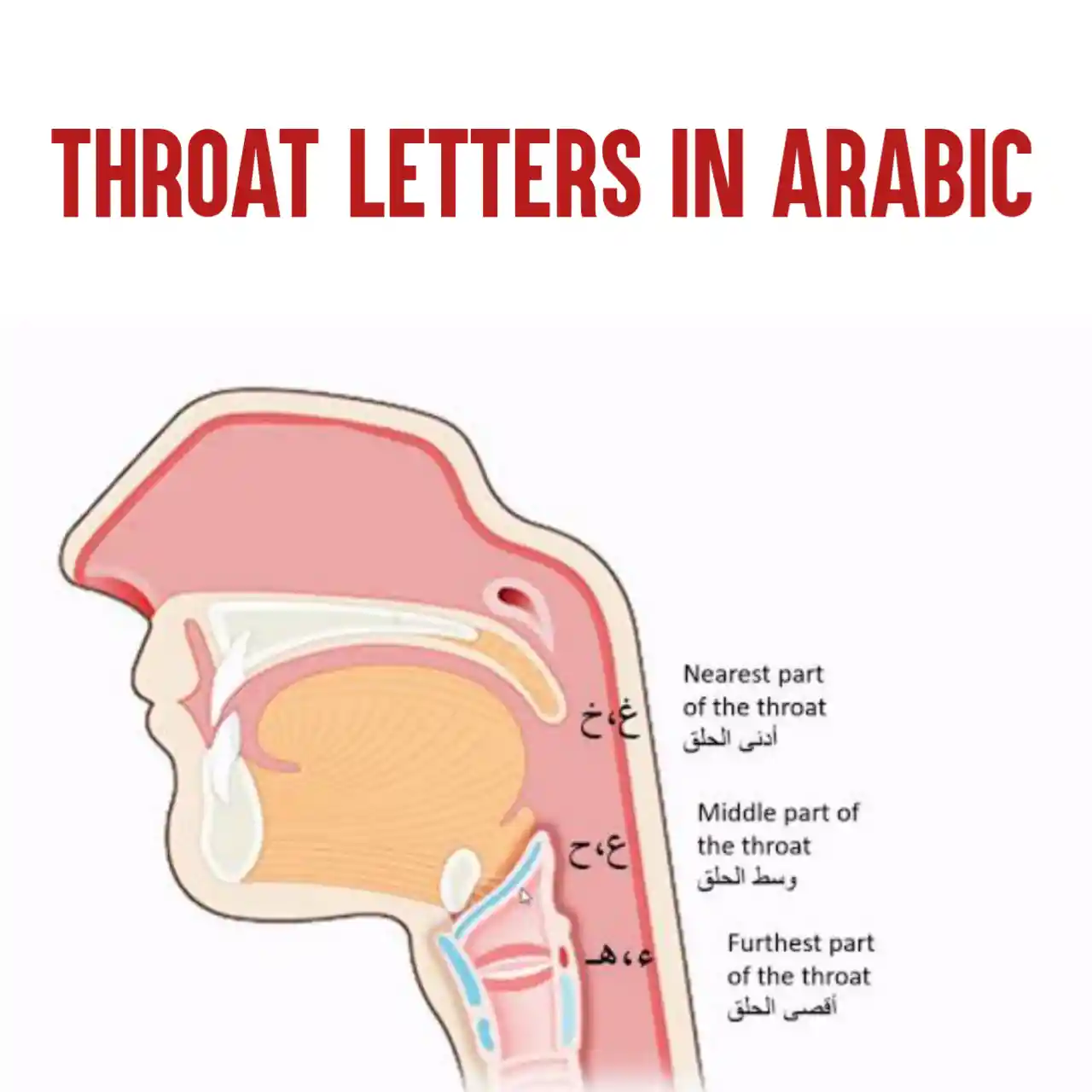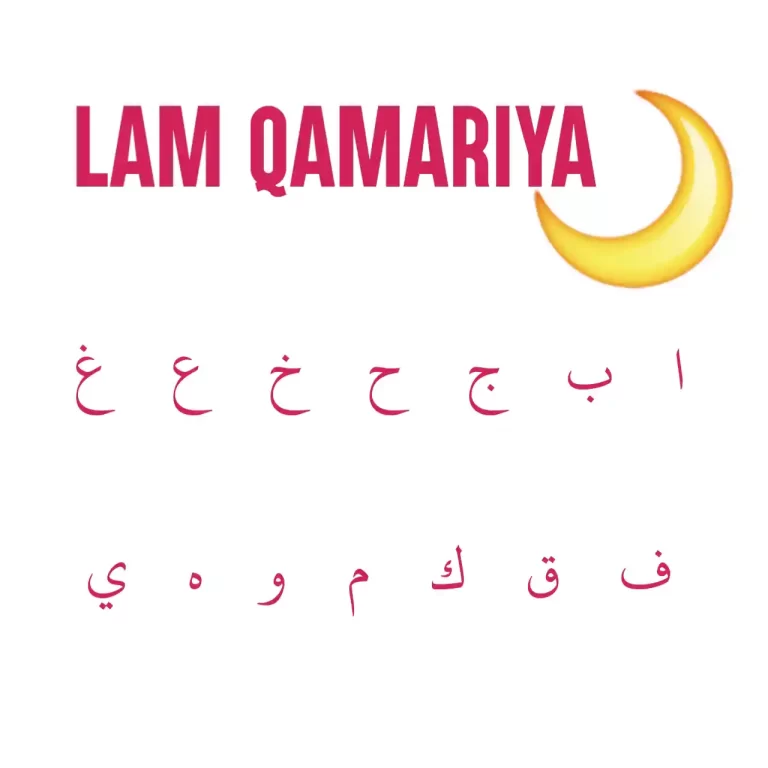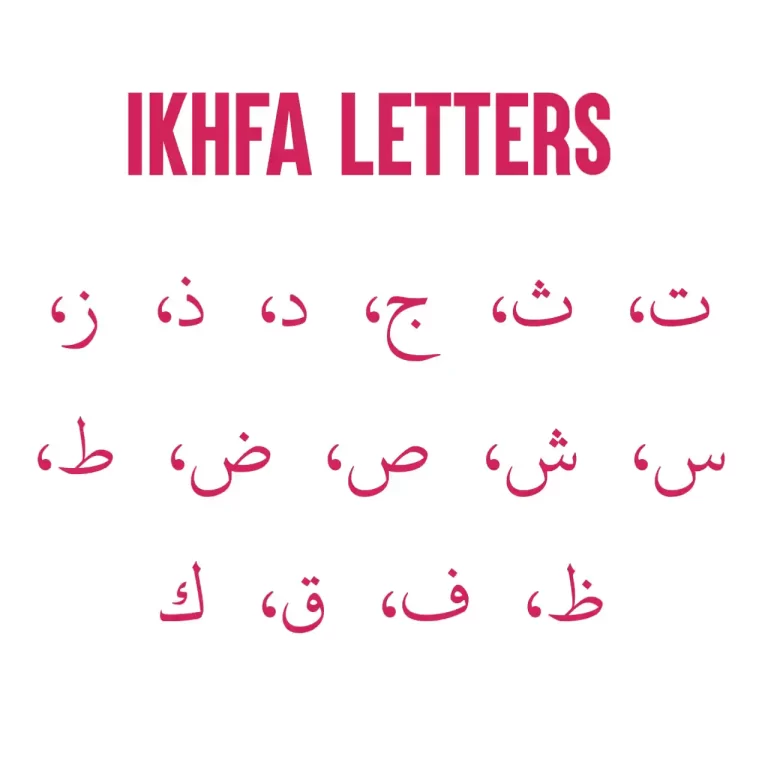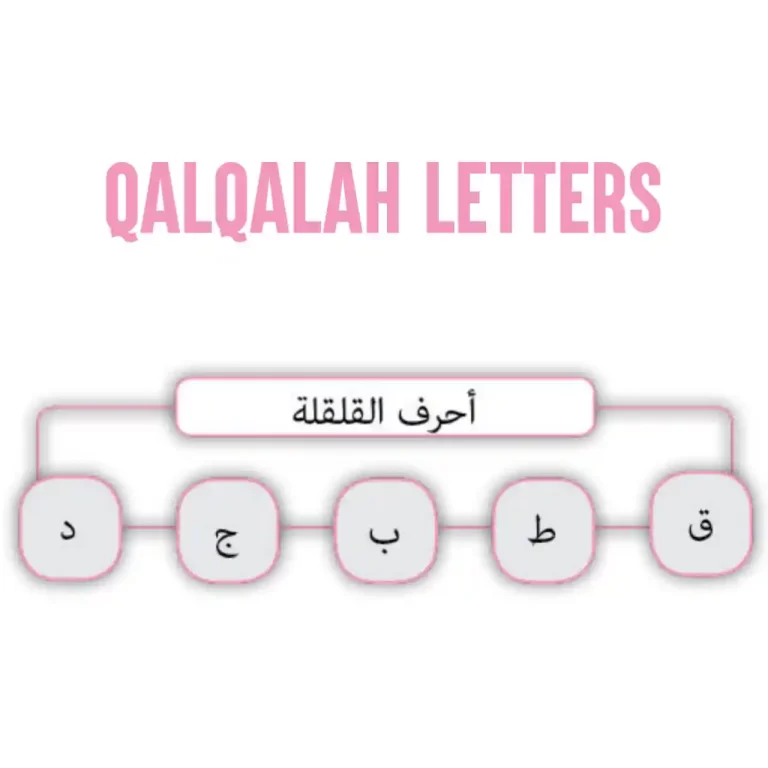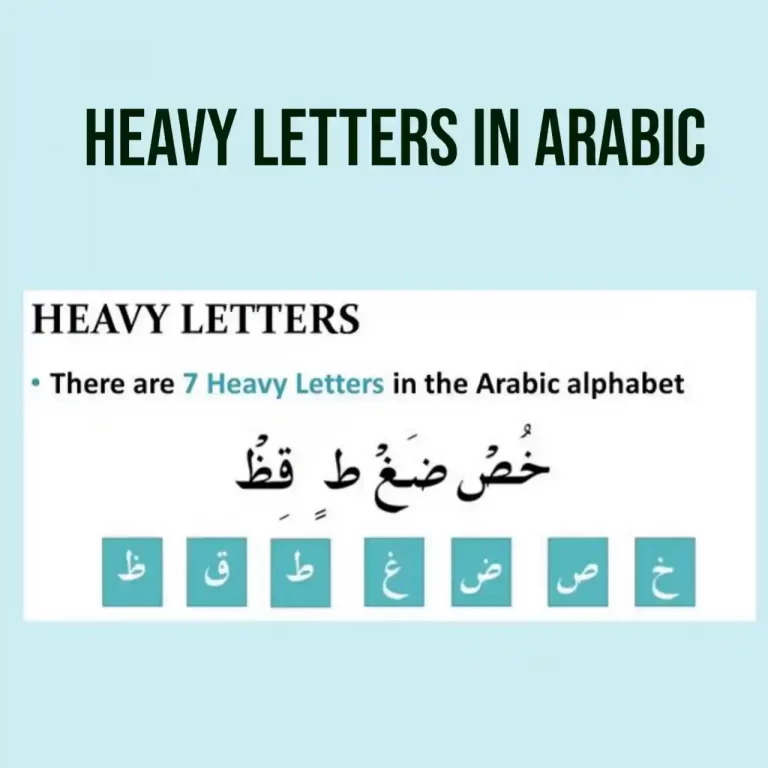Throat Letters In Arabic, Pronunciation And Examples
Being able to read the Arabic letters correctly is the foundation of Tajweed, and this is achieved by knowing where the sound originates. In Arabic, there are five major articulation point (Makhaarjul huruf) and the throat articulation point is included.
Advertisements
In this article, we will be looking at the throat letters in Arabic, their pronunciation, how to say them correctly as well as some examples.
What Are The Throat Letters In Arabic?
Arabic throat letters are six letters which share the main exiting place of the throat الحلق (halaq) and they are called “Huruf e Halqi. The throat letters is further divided into three parts, the lowest part of the throat, the middle part of the throat, and the closest part of the throat. The six throat letters in Arabic are:
- Hamza الهمزة ء
- Haa الهاء هـ
- Ayn العين ع
- Haa الحاء ح
- Ghayn الغين غ
- Khaw الخاء خ
Within the throat, there are three points of articulation. Two letters emerge from each makhraj. Let’s take a look at these with detail.
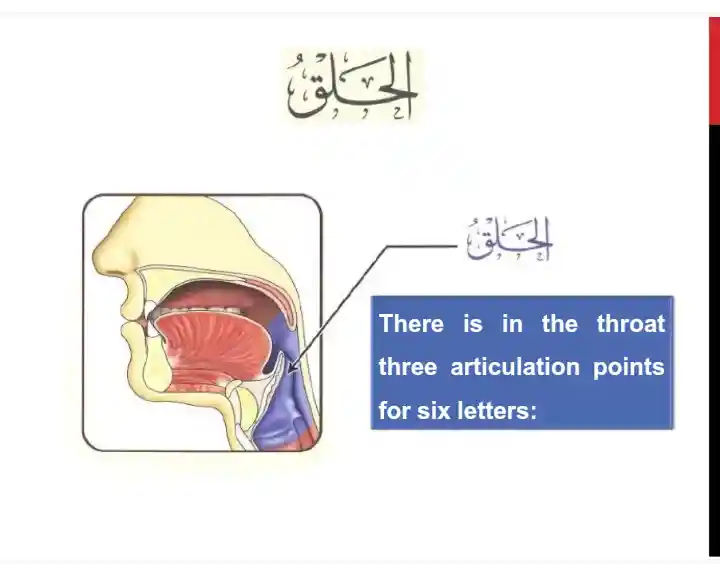
The Upper Throat – Adnal-halq (ادنى الحلق)
From the upper throat emerge two letters. These are:
Advertisements
- Khaa’ ( خ ), pronounced “kh”
- Gyan ( غ ), pronounced “gh”
Pronouncing these two letters from the mouth is incorrect, and every effort should be made to distinguish the upper throat from the inner mouth area. Ghayn is articulated from the same makhraj as khaa, but just below it.
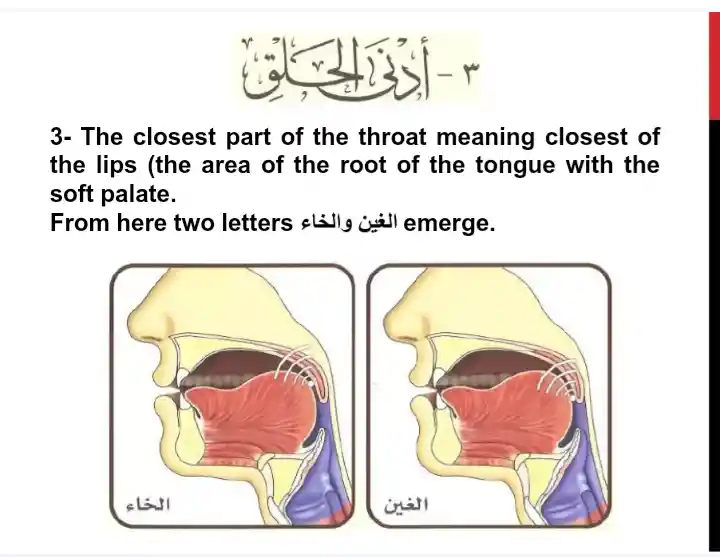
The Mid-Throat – Wasat Al-halq (وسط الحلق)
The mid-throat is the point of articulation for the following two:
- Haa’ ( ح ), pronounced “hh“
- ‘Ayn ( ع ), pronounced ” ‘a “
It is important to understand that haa (ح) and haa (هـ) are not the same, and that haa has a much sharper sound and is articulated slightly above the ‘ayn.
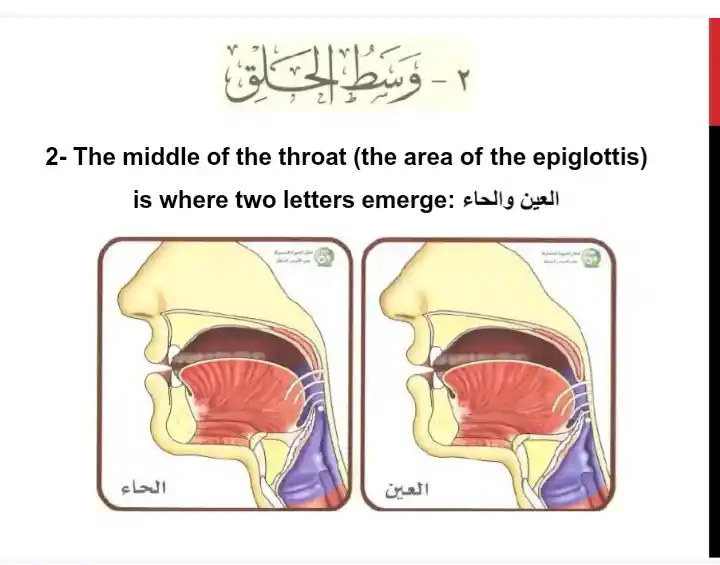
The Deep Throat – Aqsal-halq (اقصي الحلق)
The deepest part of the throat produces two letters:
- Haa’ ( هـ ), pronounced “hh”
- Hamzah ( ء ), pronounced as a glottal stop
The definition of a glottal stop is “a speech sound produced by a momentary complete closure of the glottis followed by an explosive release.” The haa emerges from the same location as the hamzah, but just above the point of articulation.
Advertisements
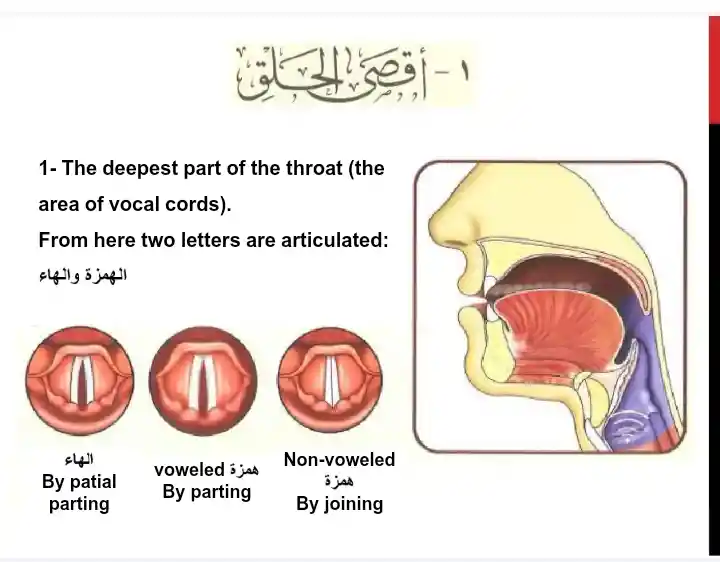
Learn 7 Heavy Letters In Arabic (Tafkheem Letters) With Examples.
How To Pronounce Arabic Throat Letters
This video will shows details on how to pronounce these 6 letters correctly.
Pronunciation Tips For Throat Letters Arabic
These pronunciation tips will be easy for you to learn and remember them.
Advertisements
Ghayn الغين غ
To read this letter, you need to moisture the back of your throat and roll it like a “g” with the help of your tongue. It is similar to but not the same as the English letter G. It feels like you are growling.
It is made literally gargling on air. You probably do this when brushing your teeth every day, and kids do it when they drink to make bubbles in their mouths. End it with ‘ain’.
Mistakes
Mixing Ghayn’s sound with the sound of Qaaf. Ghayn is pronounced from the front of the throat, whereas Qaaf is pronounced from the back of the tongue. Some people mix Ghayn with the sound of Qaaf, like {غير المغضوب}.
Applying Idgham for Ghayn into Qaaf, the reader makes the mistake of not applying the Rakhawah characteristic (running of sound due to articulation point weakness) to the letter Ghayn, as in {لا تزغ قلوبنا}.
Changing Ghayn sound to the letter Khaw, that mistake happens because Ghayn and Khaw are produced from the same articulation point, but their characteristics are different: Ghayn has Hams (running of air), but Khaw has Jahr (stopping air), like {يخشى} and {يغشى}.
Applying Qalqalah for Ghayn. This happens when the Quran reader does not apply the characteristic of Rakhawah for Ghayn (running of sound), like {المغضوب}.
Applying strong Tafkheen (to be heavy) in the case of Ghayn with Kasrah. One should apply the lowest level of Tafkheem for Ghayn in case it has Kasrah, like {من غِل}.
Khaw الخاء خ
You need to make your mouth round and hollow in order to speak this letter aloud. It is critical not to flatten it. This letter is also known as a round letter in tajweed.
Pronounce it as if forcing phlegm out. I know it’s disgusting, but khaa’ requires less effort than you might think. End it with a sudden cut of air, as in ح. Remember not to apply too much pressure; just a slight blockage of air will do.
Mistakes
Making it light. Khaw is a heavy letter, so heaviness shall be applied for it, {خالدين}.
In the case of Khaw with Kasrah, apply strong Tafkheem (to be heavy). If Khaw has Kasrah, one should use one of the lowest levels of Tafkheem, such as {وخِيفة}.
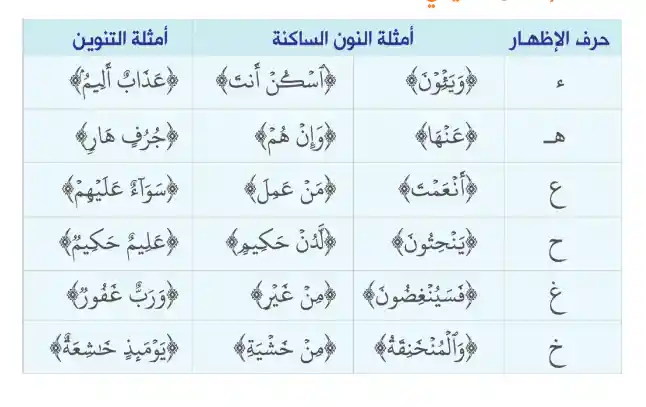
Ayn العين ع
It is a difficult letter to say, particularly for English speakers. More muscle tension is required to read this letter correctly. To pronounce it correctly, you must close and open your throat properly.
This one comes from the throat. It’s the sound you make when you gag. Follow it with an ‘eain’.
Notes
Pronouncing it near to the heavy Alif, with a point near to lips as an articulation point. The right way is to pronounce ‘Aeen from the middle of the throat, like {نعبد}.
To make its sound stop when pronouncing it with Sukoon. The right way is to let sound run to some degree when pronouncing ‘Aeen, for the articulation point of ‘Aeen is not so strong and not so weak, it has Tawasut. Example: {يعملون}.
Applying Tafkheem (to be heavy), this mistake is common especially if it is close to a heavy letter, like: {عصوا}.
Pronouncing ‘Aeen similar to the Hamza, like {يعلم}.
Haa الحاء ح
You must roar as you read this letter. However, there should be no “gh” or “kh” vibrations. To read this letter, lower your throat to the center of your throat.
Haa’ is the sound you make when you clear your throat, only keep your mouth open when you do. When we clear our throats, we usually begin by holding air and then forcefully expel it. With ح , you end the letter with suddenly cutting the air.
Note
Pronouncing Haa (ح) like Khaw (خ) or Haa (هـ), this mistake is done basically by non-Arabs, for they not used to use the articulation point of Haa (ح) which comes from the middle of the throat, so some of them find it easy to pronounce it like letter Khaw (خ) or Haa (هـ) instead, like {الرخمن الرخيم} or, like {الرهمن الرهيم}
Pronouncing it without making its characteristic of Hams (running of air) clear. Hams should be applied to the letter Haa, like {الرحمن الرحيم}
Pronouncing it unclearly especially it comes close to ‘Aeen.
‘Aeen and Haa comes from the same articulation point, that is why the characteristic of Hams in Haa should be applied properly not to find it skipped like it was mixed with ‘Aeen (have Idgham in ‘Aeen), like {فاصفح عنهم}.
Haa الهاء هـ
Some people question that both letters include H. However, you need to know that their origin changes their characteristics completely. This letter is breathy as well as deeper.
Notes
Applying Tafkheem (to be heavy) in the case of Tarqeek (to be light).
Haa is a light letter, but it is a common mistake to make it heavy especially if it is close to a heavy letter, like {النهار}.
Pronouncing weak sound of Haa, this mistake happens because of separating between the vocal cords more than required, like {اهدنا}.
Do not pronounce the sound of Haa clearly if it is close to another Haa or a sound very near to Haa like the letter (ح), like {جباههم}{وسبحه ليلا}.
Pronouncing weak sound of Haa, or change its sound to the sound of Alif, in case stopping, like {الحاقة}
Hamza الهمزة ء
You need to read it like the “Alif” which is silent. For instance, you use A for an apple. Alif and Hamza are interchangeable. However, there are a few tutors who will tell you that it is Hamza all the time.
The backward-shaped “2” resides at the top of Alif. It is read sharply and clearly with a flat tongue. You do not have to round your mouth to read it.
Applying Tafkheem (to be heavy) in the case of Tarqeek (to be light).
Hamza is a light letter, but it is a common mistake to make it heavy especially if hamza is close to a heavy letter, like {أصابعهم}.
Applying Tasheel (not closing the articulation point of Hamza completely) in a case of Tahqiq (closing it completely), like {يا أيها}.
Making Hamza sound too weak not to be heard. This mistake happens in case of stopping, like {السماء}.
Conclusion
To sum up, the six letters that emerge from the throat are: khaa’, ghayn, haa’, ayn, haa, and hamzah. These six letters are called Al-Ahruf Al-Halqiyyah (the throat letters in Arabic).
Advertisements

